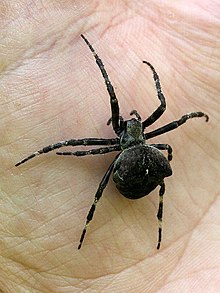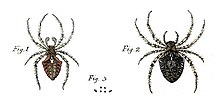
The spider species Araneus diadematus is commonly called the European garden spider, cross orbweaver, diadem spider, orangie, cross spider, and crowned orb weaver. It is sometimes called the pumpkin spider, although this name is also used for a different species, Araneus marmoreus. It is an orb-weaver spider found in Europe, where it is native, and North America, where it was introduced.

Systema Naturae is one of the major works of the Swedish botanist, zoologist and physician Carl Linnaeus (1707–1778) and introduced the Linnaean taxonomy. Although the system, now known as binomial nomenclature, was partially developed by the Bauhin brothers, Gaspard and Johann, Linnaeus was the first to use it consistently throughout his book. The first edition was published in 1735. The full title of the 10th edition (1758), which was the most important one, was Systema naturæ per regna tria naturæ, secundum classes, ordines, genera, species, cum characteribus, differentiis, synonymis, locis, which appeared in English in 1806 with the title: "A General System of Nature, Through the Three Grand Kingdoms of Animals, Vegetables, and Minerals, Systematically Divided Into their Several Classes, Orders, Genera, Species, and Varieties, with their Habitations, Manners, Economy, Structure and Peculiarities".

Carl Alexander Clerck was a Swedish entomologist and arachnologist.

Tord Tamerlan Teodor Thorell was a Swedish arachnologist.

Araneus quadratus, the four-spot orb-weaver, is a common orb-weaver spider found in Europe and Central Asia, and as far as the Kamchatka Peninsula and Japan. Females can reach 17 mm in length, especially when gravid, with males around half that. They are quite variable in appearance, ranging from brown to bright orange or green, but they always have the characteristic four white spots on the abdomen. The darker color morphs are easier to identify, due to the contrast between the white spots and the rest of the body. The legs are sometimes brightly striped.
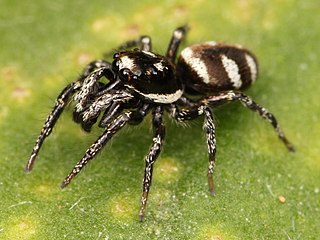
The zebra spider is a common jumping spider of the Northern Hemisphere. Their common name refers to their vivid black-and-white colouration, whilst their scientific name derives from Salticus from the Latin for “jump”, and the Greek scenicus, translating to “theatrical” or “of a decorative place,” in reference to the flashy, zebra-like coloration of the species.

The raft spider, scientific name Dolomedes fimbriatus, is a large semi-aquatic spider of the family Dolomedidae found throughout north-western and central Europe. It is one of only two species of the genus Dolomedes found in Europe, the other being the slightly larger Dolomedesplantarius which is endangered in the UK.

Araneus is a genus of common orb-weaving spiders. It includes about 650 species, among which are the European garden spider and the barn spider. The genus was erected by Carl Alexander Clerck in 1757.

Aelurillus v-insignitus is a species of jumping spiders.

Nuctenea umbratica, the walnut orb-weaver spider, is a species of spider in the family Araneidae.

Nuctenea is a genus of orb-weaver spiders first described by Eugène Simon in 1895. Its most familiar member is the Walnut Orb-Weaver Spider, N. umbratica.

Araniella cucurbitina, sometimes called the "cucumber green spider", is a spider of the family Araneidae. Araniella cucurbitina is found across Europe, Western Asia, Central Asia and Japan. The cucurbitina in the name comes from the word cucurbit which is a family of plants including cucumbers.

Zygiella x-notata, sometimes known as the missing sector orb weaver or the silver-sided sector spider, is a spider species in the family Araneidae. They are solitary spiders, residing in daily spun orb webs. Z. x-notata is a member of the genus Zygiella, the orb-weaving spiders. The adult female is easily recognized by the characteristic leaf-like mark on her posterior opisthosoma, caudal to the yellow-brown cephalothorax.
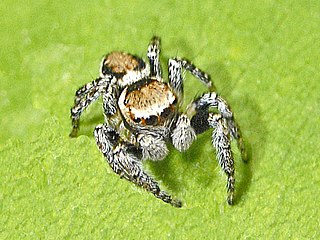
Evarcha falcata is a species of 'jumping spiders' belonging to the family Salticidae.
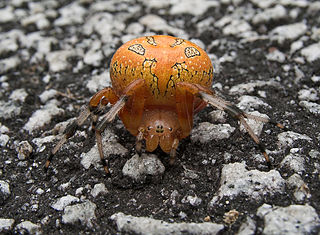
Araneus marmoreus, commonly called the marbled orbweaver, is a species of spider belonging to the family Araneidae. It is sometimes also called the pumpkin spider from the resemblance of the female's inflated abdomen to an orange pumpkin. It has a Holarctic distribution.

The book Svenska Spindlar or Aranei Svecici is one of the major works of the Swedish arachnologist and entomologist Carl Alexander Clerck and was first published in Stockholm in the year 1757. It was the first comprehensive book on the spiders of Sweden and one of the first regional monographs of a group of animals worldwide. The full title of the work is Svenska Spindlar uti sina hufvud-slägter indelte samt under några och sextio särskildte arter beskrefne och med illuminerade figurer uplyste – Aranei Svecici, descriptionibus et figuris æneis illustrati, ad genera subalterna redacti, speciebus ultra LX determinati, and included 162 pages of text and six colour plates. It was published in Swedish, with a Latin translation printed in a slightly smaller font below the Swedish text.

Araneus mitificus, commonly known as the kidney garden spider or pale orb weaver is a species of orb-weaver spider found in South, East, and Southeast Asia.

Araneus grossus is a orb-weaver spider species. The species is one of the largest orb-weaver spiders in Europe. It is found in South and Southeast Europe and Central Asia.

Salsa is an Australasian genus of orb-weaver spiders.
